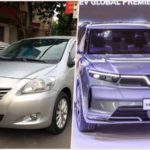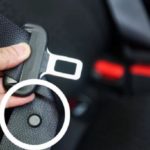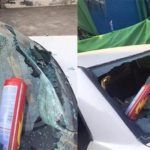However, this conventional method of testing mainly relies on the experience of each individual, therefore it is difficult to determine whether a car has been flooded. Used car buyers should therefore carefully investigate the origin of the car instead of making impulsive purchases.
Here are some suggested checklists to identify whether a car has been flooded or not.
Check the headlights
Firstly, when inspecting the car with the naked eye, the buyer should observe the area of the headlights. If the car has been flooded, the headlight covers often show yellow stains, foggy appearance, water stains, or scratches from being removed for cleaning purposes.
Check all the bolts and screws on the car
In addition to observing the headlights, the buyer should also check the positions of the bolts and screws. If there are signs of rust, scratches, clamps, loosening or even a shiny bolt, they are all indications that the car has been repaired and replaced.

Illustrative image: VNE
In addition, the buyer should also pay attention to all the bolts on the engine, the fuel lines, the radiator or the wiring… to see if there are any traces of oil or grease, as this could be a sign of dismantlement.
Check the engine gasket and the engine cover
In this detail, if the engine gasket and the engine cover are brand new or the silicone is overflowing, it means that the engine has been tampered with from the outside. Normally, for an original car that has never been opened, this gasket will be tight and the silicone line will be very straight.
Check the interior compartment of the car
If a car has been flooded, when stepping inside, the buyer will feel a strong musty smell. The previous owner or the seller may use various perfumes or deodorants to cover up the musty smell in the car compartment.
Therefore, to verify this, the buyer should enter the car, close all the doors and turn off the air-conditioning system. If the perfume or deodorant smell is too strong or the musty smell is obvious, the buyer should avoid choosing such cars.
In addition, the buyer needs to lift the floor mat and check if there is any mud sticking to the area under the floor or floor gaps. If there are any abnormalities when checking the area under the brake pedal, accelerator pedal, seat base bolts… the buyer should avoid it.
Check the undercarriage and exhaust system
The area under the car is where many metal details gather, and moreover, this is also the first and most exposed area to water. Therefore, when buying a car, the buyer should check the entire undercarriage to detect details that have rust, yellow stains, or signs of disassembly.
Take a test drive
In addition to visually inspecting the car, the buyer must perform the final check by driving the car to feel its performance.
First, the buyer needs to start the engine to listen to the sound from the exhaust pipe and see if there is any smoke. Then, accelerate from slow to fast to feel the sensitivity of the accelerator pedal, the brake pedal, the steering system, and the stability of the body when making high-speed turns.
According to VTC News





































